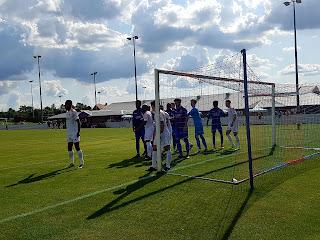Skinners Field
Combined Counties League Division One
November 4, 2017
Ground No 200
WHENEVER I think of Worcester Park, my mind races back to my very first job - in a posh West London store - and a particularly dopey casual sales assistant brought in to help with the Christmas rush.
The store offered a free delivery service throughout the London area and said sales assistant - who probably stood to inherit half of Hampshire on completion of his Oxbridge degree in applied bionics but had absolutely no common sense - caused massive panic in the grocery department by marking a huge package to loaded onto the van for free delivery to Worcester. Apparently he hadn't heard of Worcester and thought it was the same as Worcester Park.
Anyway fast forward 30-odd years and I find myself in Worcester Park to visit my 200th football ground.
I'd seen it Skinners Field from the window of a train as it stopped at Worcester Park railway station, slap bang next to the ground, although I decided to drive on this occasion.
The way in isn't obvious (we later found a big Worcester Park FC sign hiding behind a shrub on the other side of the entrance) and there's no on site parking so there's no car park entrance to offer a clue but the ground is hemmed in by roads, the railway and a stream so it doesn't take too much to work out where it could be.
After crossing a small bridge over the stream, you find yourself at the back of a good sized bar/clubhouse and café (two teas and a bag of Maltesers for £1.80 and a great selection of cooked food) - head to the right and you're on your way in.
If you had to envision a ground at the bottom level of the pyramid, you'd probably come up with an image of Skinners Field.
Basic, functional, no floodlights and just a tad quirky, it's unlikely to change and despite being flying high in the league the club have already been told to forget about promotion because their ground doesn't meet the required standards. In fact more than that - they've been told they will be relegated out of the league regardless if where they finish!
Spectators are only permitted on one side of the ground and behind one goal.
A flat hard hard-standing area on the side that's not out of bounds leads to the ground's only stand - a small structure with three shallow steps, leaning against the changing rooms. Built into it are the dugouts.
Beyond that the pitch is just roped off rather than fenced off and the paving slabs through a grassed area towards a wooden building at the back make you feel like you're walking through someone's back garden to the shed rather than strolling along the perimeter of a football pitch.
Behind the goal is the railway line and some cricket nets while on the far side the pitch blends seamlessly into the cricket pitch used during the summer (there's also a bowling green and tennis courts in this multi-sport facility).
Behind the remaining end is a hard standing area, picnic tables and all, in front of the bar/clubhouse and snack bar.
There's also a sturdy brick wall and a flood gate, complete with strict orders to keep it closed at all times. This is on account of the fact that the Environment Agency were rather too keen to make the pitch a flood plain.
Thankfully a new drainage system, a wall and a gate that must never be opened put an end to those plans.

















































